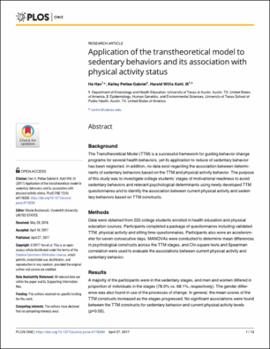| dc.contributor.author | Han, Ho | |
| dc.contributor.author | Pettee Gabriel, Kelley | |
| dc.contributor.author | Kohl, Harold Willis, III | |
| dc.date.accessioned | 2022-04-19T20:21:16Z | |
| dc.date.available | 2022-04-19T20:21:16Z | |
| dc.date.issued | 2017-04-27 | |
| dc.identifier | oksd_han_applicationofthetranstheoretical_2017 | |
| dc.identifier.citation | Han, H., Pettee Gabriel, K., & Kohl, H. W., III (2017). Application of the transtheoretical model to sedentary behaviors and its association with physical activity status. PLoS ONE, 12(4), Article e0176330. https://doi.org/10.1371/journal.pone.0176330 | |
| dc.identifier.uri | https://hdl.handle.net/11244/335269 | |
| dc.description.abstract | Background: The Transtheoretical Model (TTM) is a successful framework for guiding behavior change programs for several health behaviors, yet its application to reduce of sedentary behavior has been neglected. In addition, no data exist regarding the association between determinants of sedentary behaviors based on the TTM and physical activity behavior. The purpose of this study was to investigate college students' stages of motivational readiness to avoid sedentary behaviors and relevant psychological determinants using newly developed TTM questionnaires and to identify the association between current physical activity and sedentary behaviors based on TTM constructs. | |
| dc.description.abstract | Methods: Data were obtained from 225 college students enrolled in health education and physical education courses. Participants completed a package of questionnaires including validated TTM, physical activity and sitting time questionnaires. Participants also wore an accelerometer for seven consecutive days. MANOVAs were conducted to determine mean differences in psychological constructs across the TTM stages, and Chi-square tests and Spearman correlation were used to evaluate the associations between current physical activity and sedentary behavior. | |
| dc.description.abstract | Results: A majority of the participants were in the sedentary stages, and men and women differed in proportion of individuals in the stages (78.0% vs. 68.1%, respectively). The gender difference was also found in use of the processes of change. In general, the mean scores of the TTM constructs increased as the stages progressed. No significant associations were found between the TTM constructs for sedentary behavior and current physical activity levels (p>0.05). | |
| dc.description.abstract | Conclusions: A high proportion of college students were in sedentary stages regardless of physical activity levels, but different distributions in men and women. Participants in earlier stages were less likely to utilize the TTM constructs to reduce sedentary behaviors than those in later stages. A lack of association between physical activity and the psychological determinants of sedentary behavior was found. | |
| dc.format | application/pdf | |
| dc.language | en_US | |
| dc.publisher | Public Library of Science (PLoS) | |
| dc.relation.ispartof | PLoS ONE, 12 (4) | |
| dc.relation.uri | https://www.ncbi.nlm.nih.gov/pubmed/28448531 | |
| dc.rights | This material has been previously published. In the Oklahoma State University Library's institutional repository this version is made available through the open access principles and the terms of agreement/consent between the author(s) and the publisher. The permission policy on the use, reproduction or distribution of the material falls under fair use for educational, scholarship, and research purposes. Contact Digital Resources and Discovery Services at lib-dls@okstate.edu or 405-744-9161 for further information. | |
| dc.subject.mesh | Adolescent | |
| dc.subject.mesh | Exercise | |
| dc.subject.mesh | Female | |
| dc.subject.mesh | Health Behavior | |
| dc.subject.mesh | Humans | |
| dc.subject.mesh | Male | |
| dc.subject.mesh | Models, Psychological | |
| dc.subject.mesh | Motivation | |
| dc.subject.mesh | Sedentary Behavior | |
| dc.subject.mesh | Time Factors | |
| dc.subject.mesh | Young Adult | |
| dc.title | Application of the transtheoretical model to sedentary behaviors and its association with physical activity status | |
| dc.date.updated | 2022-04-12T18:24:34Z | |
| osu.filename | oksd_han_applicationofthetranstheoretical_2017.pdf | |
| dc.description.peerreview | Peer reviewed | |
| dc.identifier.doi | 10.1371/journal.pone.0176330 | |
| dc.description.department | Community Health Sciences, Counseling and Counseling Psychology | |
| dc.type.genre | Article | |
| dc.type.material | Text | |
| dc.subject.keywords | Clinical Research | |
| dc.subject.keywords | Prevention | |
| dc.subject.keywords | Behavioral and Social Science | |
| dc.subject.keywords | Cardiovascular | |
| dc.subject.keywords | Mind and Body | |
| dc.subject.keywords | Cancer | |
| dc.subject.keywords | General Science & Technology | |
| dc.rights.license | https://creativecommons.org/licenses/by/4.0/ | |
| dc.identifier.author | ORCID: 0000-0003-4241-7317 (Han, H) | |
| dc.identifier.author | ScopusID: 57191291072 (Han, H) | |
| dc.identifier.author | ScopusID: 57195991119 (Gabriel, KP) | |
| dc.identifier.author | ScopusID: 7102530211 (Kohl, HW) | |
